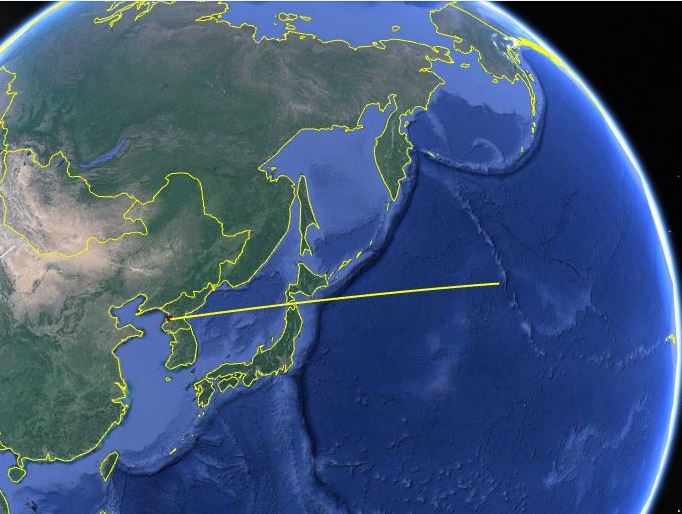North Korea conducted another missile test at 6:30 am September 15 Korean time (early evening on September 14 in the US). Like the August 28 test, this test appears to have been a Hwasong-12 missile launched from a site near the Pyongyang airport. The missile followed a standard trajectory—rather than the highly lofted trajectories North Korea used earlier this year—and it flew over part of the northern Japanese island of Hokkaido (Fig. 1).

Fig. 1. Approximate path of the launch.
The missile reportedly flew 3,700 kilometers (km) (2,300 miles) and reached a maximum altitude of 770 km (480 miles). It was at an altitude of 650 to 700 km (400 to 430 miles) when it passed over Hokkaido (Fig. 2).

Fig. 2. The parts of Hokkaido the missile flew over lie about 1,250 to 1,500 km (780-930 miles) from the missile launch point.
The range of this test was significant since North Korea demonstrated that it could reach Guam with this missile, although the payload the missile was carrying is not known. Guam lies 3,400 km from North Korea, and Pyongyang has talked about it as a target because of the presence of US forces at Anderson Air Force Base.
This missile very likely has low enough accuracy that it could be difficult for North Korea to use it to destroy this base, even if the missile was carrying a high-yield warhead. Two significant sources of inaccuracy of an early generation missile like the Hwasong-12 are guidance and control errors early in flight during boost phase, and reentry errors due to the warhead passing through the atmosphere late in flight. I estimate the inaccuracy of the Hwasong-12 flown to this range to be likely 5 to 10 km, although possibly larger.
Even assuming the missile carried a 150 kiloton warhead, which may be the yield of North Korea’s recent nuclear test, a missile of this inaccuracy would still have well under a 10% chance of destroying the air base. (For experts: This estimate assumes the air base would have to fall within the warhead’s 5 psi air blast radius, which is 3.7 km, and that the CEP is 5 to 10 km.)
Heating of the reentry vehicle
As I’ve done with some previous tests, I looked at how the heating experienced by the reentry vehicle (RV) on this test compares to what would be experienced by the same RV on a 10,000 km-range missile on a standard trajectory (MET). My previous calculations were done on North Korea’s highly lofted trajectories, which tended to give high heating rates but relatively short heating times.
Table 1 shows that in this case the duration of heating (τ) would be roughly the same in the two cases. However, not surprisingly because of the difference in ranges and therefore of reentry speeds, the maximum heating rate (q) and the total heat absorbed (Q) by the RV on this trajectory is only about half that of the 10,000 km trajectory.

Table 1. A comparison of RV heating on the September 15 missile test and on a 10,000 km-range trajectory, assuming both missiles have the same RV and payload. A discussion of these quantities can be found in the earlier post.
So while it seems likely that North Korea can develop a heat shield that would be sufficient for a 10,000 km range missile, this test does not demonstrate that.
